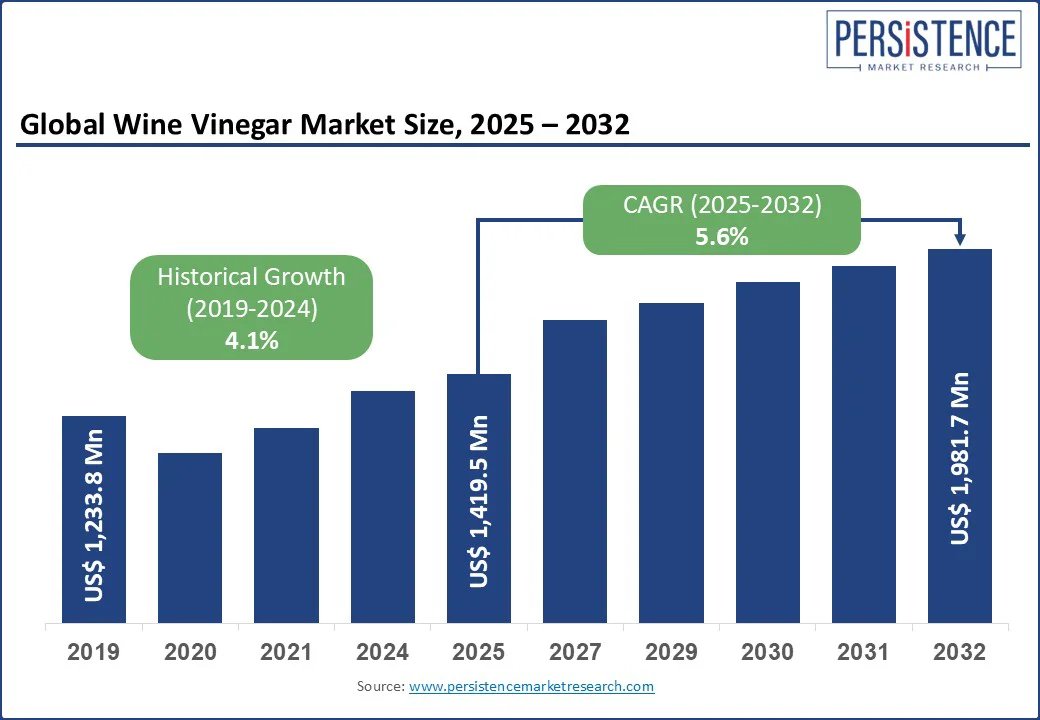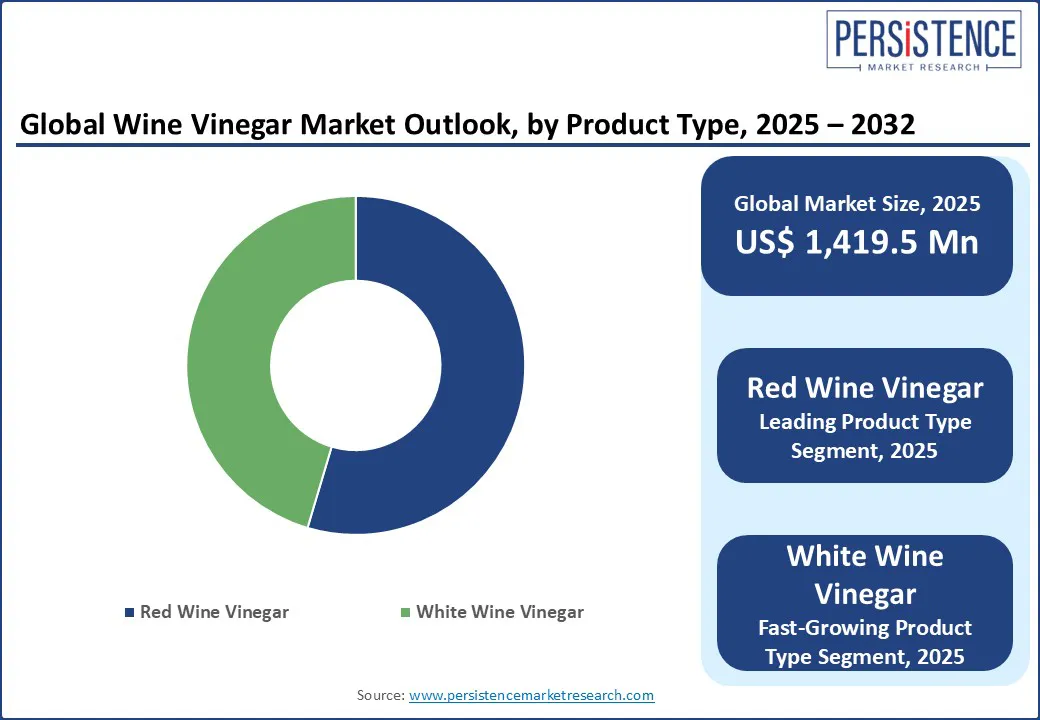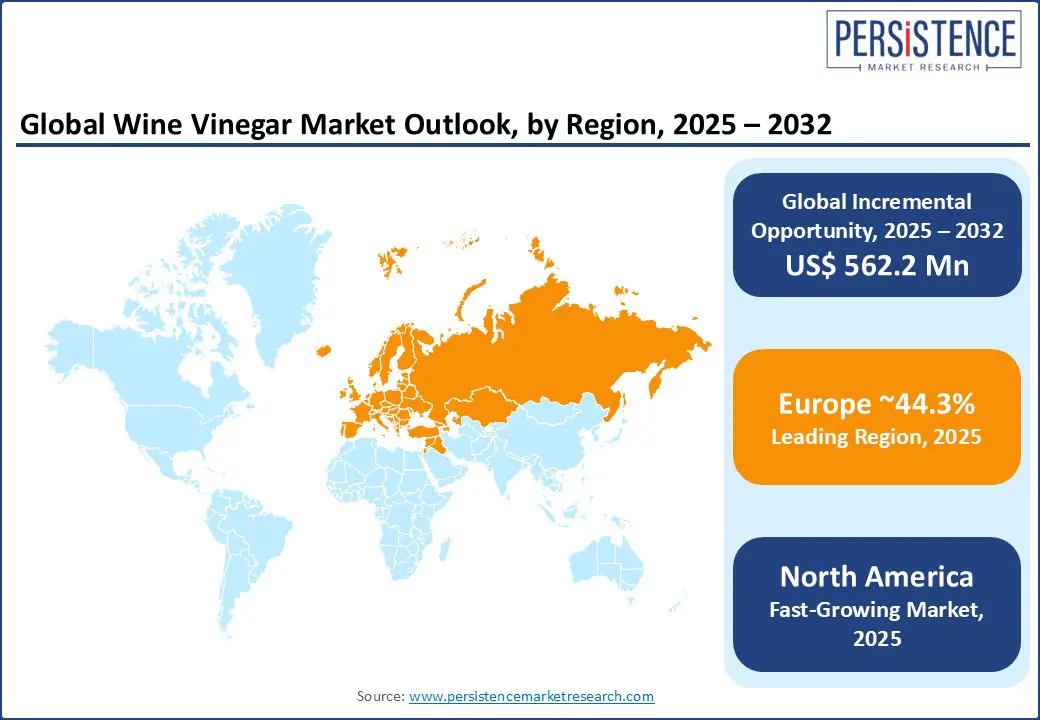ID: PMRREP35505| 196 Pages | 22 Jul 2025 | Format: PDF, Excel, PPT* | Food and Beverages

The wine vinegar market size is likely to be valued at US$ 1,419.5 Mn in 2025 and is estimated to reach US$ 1,981.7 Mn in 2032, growing at a CAGR of 5.6% during the forecast period 2025-2032. The dressing vinegar and condiments sector is undergoing a strategic transformation, propelled by shifting consumer preferences toward natural, functional, and premium food ingredients. In this market, wine vinegar is emerging as a high-value segment with applications expanding beyond traditional cooking into beverage formulations and clean-label food manufacturing. Leading players are capitalizing on this momentum through product differentiation based on grape origin, aging techniques, and health-oriented positioning. Growth is also supported by the high popularity of Mediterranean diets and rising demand for low-fat alternatives.

Key Industry Highlights:
|
Global Market Attribute |
Key Insights |
|
Wine Vinegar Market Size (2025E) |
US$ 1,419.5 Mn |
|
Market Value Forecast (2032F) |
US$ 1,981.7 Mn |
|
Projected Growth (CAGR 2025 to 2032) |
5.6% |
|
Historical Market Growth (CAGR 2019 to 2024) |
4.1% |
The use of wine vinegar as a substitute for salt and fat is emerging as a key demand driver, specifically in markets responding to public health initiatives and dietary shifts. In Europe, for instance, governments are pushing salt reduction strategies. Hence, vinegar is being highlighted in culinary workshops and hospital nutrition programs as a flavor enhancer that compensates for reduced sodium. In the U.S., the trend toward low-fat, whole-food-based diets has led chefs to incorporate wine vinegar in marinades, dressings, and sauces to add acidity and depth without relying on oils or butter.
In Asia Pacific, especially in Tokyo and Seoul, recipe apps and cooking classes are showcasing wine vinegar in low-salt dishes such as cold noodles, stir-fries, and pickles. This culinary shift is also influencing foodservice, with restaurants designing low-sodium menus where wine vinegar plays a central flavor role. The broad movement toward functional eating and cardiovascular wellness is hence directly contributing to the surging relevance of wine vinegar in everyday cooking.
Concerns over digestive side effects such as acid reflux, heartburn, and mucosal irritation are creating a cautious consumer segment, hampering the wine vinegar market growth to a certain extent. Medical advisories and nutrition forums frequently warn against excessive consumption of acidic foods such as wine vinegar, mainly for individuals with GERD or peptic ulcers. The American Gastroenterological Association, for instance, continues to list vinegar as a common reflux trigger, which has led to its exclusion from several gut-health oriented diets.
The perception is directly affecting its use in health-focused packaged foods and meal services. Brands promoting gut-friendly or alkaline diets often avoid wine vinegar, opting instead for milder alternatives such as apple cider vinegar, which is perceived as more tolerable. A few health-conscious consumers are now showing preference for fermented vinegars with low acidity levels or those blended with herbs and probiotics designed to reduce gastric irritation.
Increasing focus on premiumization is unlocking new opportunities for wine vinegar brands to position themselves not just as condiments, but as artisanal products. This shift is visible in Germany, the U.S., and Australia, where gourmet food sales are steadily climbing. Premium wine vinegars aged in oak barrels, crafted from single-origin grapes, or infused with rare ingredients, are finding shelf space in high-end retailers and online gourmet platforms such as Dean & DeLuca and Williams-Sonoma.
Producers are responding with refined branding, limited-edition releases, and storytelling that emphasizes regional identity, slow fermentation, and sustainable sourcing. For example, Italy-based brand Leonardi offers aged wine vinegars packaged in numbered bottles with tasting notes, targeting the same consumers who appreciate craft spirits or fine olive oil. Premiumization is also bolstering collaboration between vineyards and vinegar makers, turning surplus or off-spec wine into value-added products.
Based on product type, the market is bifurcated into red and white wine vinegar. Among these, red wine vinegar is predicted to account for around 54.6% of share in 2025 owing to its deep flavor complexity and versatility across savory applications. It contains a higher concentration of polyphenols and residual wine tannins compared to white wine vinegar. Hence, it provides a bold, slightly fruity acidity that enhances meats, stews, and Mediterranean-style salads. This rich flavor profile has made it a staple in marinades and braising liquids, primarily in cuisines that demand depth without overpowering sweetness.
White wine vinegar is gaining impetus primarily due to its light flavor profile, which makes it ideal for modern, minimalist cuisine. Chefs and home cooks are using it in dishes where red wine vinegar would be too overpowering or visually disruptive such as in hollandaise sauces. This versatility is making it the go-to vinegar in health-forward and aesthetic-focused cooking styles. Additionally, white wine vinegar is finding traction in beverage innovation and wellness-oriented formulations.
In terms of application, the wine vinegar market is divided into culinary, beverages, diet and metabolism, folk medicine, and household. Out of these, the culinary segment will likely hold about 34.2% of share in 2025 as it capitalizes on the ingredient’s ability to improve flavor while meeting the current preferences for natural additions in food. Wine vinegar delivers nuanced acidity rooted in grape varietals, fermentation methods, and aging processes. This makes it important in high-end and home gourmet cooking. Its ability to balance richness in fatty foods has also made it suitable for salad dressings, reductions, marinades, and glazes.
Beverages are emerging as a key application with increasing demand for functional drinks that deliver health benefits without added sugars or synthetic additives. Wine vinegar, particularly when blended with botanicals or fruit extracts, is being positioned as a natural source of acetic acid. It caters to consumers looking for low-calorie, gut-friendly alternatives with a sophisticated flavor profile. Also, wine vinegar’s compatibility with fermentation trends and non-alcoholic mixology is broadening its role in premium mocktails and health-focused café menus.

In North America, the market is experiencing a gradual shift from bulk commodity use to premium culinary applications. It is mainly augmented by the rise of gourmet home cooking and health-conscious consumers. While traditional white and red wine vinegar are still staples in dressings, there is a surging preference for organic, small-batch, and varietal-based wine vinegars. This change is being spurred by specialty food retailers such as Whole Foods Market, Inc., which are extending their artisanal vinegar offerings to appeal to urban consumers.
The U.S. wine vinegar market is seeing a spike in imports of white vinegar from Europe. Domestic producers such as O Olive Oil & Vinegar and American Vinegar Works are responding with craft products that use wine from local vineyards and focus on slow fermentation processes. They are hence positioning themselves against the mass-produced vinegars typically sold in large grocery chains. In Canada, the trend is slightly more niche, with premium wine vinegar usage concentrated in metropolitan areas, including Vancouver.
In 2025, Europe is expected to account for nearly 44.3% of the wine vinegar market share due to ongoing premiumization and product segmentation. Italy, France, and Spain dominate both production and consumption, boosted by centuries-old culinary traditions. Italy-based wine vinegars, mainly those from Modena and Reggio Emilia, have seen increasing demand for PDO- and PGI-certified variants. Producers are investing in aging techniques and packaging that appeal to international gourmet markets.
Innovation in the category is visible in the form of varietal-specific vinegars such as Merlot or Tempranillo vinegar. These are being marketed for their pairing potential with specific dishes or wines. France-based producers, including Huilerie Beaujolaise, are launching wine vinegars aged in oak barrels, which appeal to connoisseurs and upscale restaurants. In addition, Spain-based La Chinata are tapping into the gourmet food trend by offering wine vinegars infused with smoked paprika, truffle, or fig.
In Asia Pacific, wine vinegar is still a niche product but is gradually gaining impetus among urban, health-conscious consumers and upscale culinary markets. Traditionally, vinegar consumption in the region has been dominated by rice, black, and coconut vinegar, especially in China, Japan, and the Philippines. The influence of international cuisine is, however, creating new demand pockets for wine vinegar and cultured sugar vinegar, mainly in metropolitan areas of Australia, India, and South Korea.
Australia is emerging as a regional production and consumption hub. Local artisanal producers such as Lirah Vinegar and Maggie Beer are crafting small-batch wine vinegars using locally sourced wine. In India, it is considered an imported product but is seeing traction through premium food retailers, including Foodhall and Nature’s Basket. These have extended their offerings of red and white wine vinegars from brands in Europe. South Korea-based cooking influencers and recipe apps have also started incorporating wine vinegar in fusion dishes, exposing millennial consumers to its culinary versatility.

The wine vinegar market is fragmented but shows signs of strategic consolidation, specifically in premium and organic segments. Europe-based producers maintain a stronghold due to long-standing regional expertise and Geographical Indication (GI) certifications that add value and authenticity. Private-label expansion is also reshaping competition. Supermarkets in North America and Europe are increasingly introducing in-house wine vinegar products that are priced competitively but offer acceptable quality. It is putting pressure on mid-tier brands that do not have strong branding or artisanal positioning.
The market is projected to reach US$ 1,419.5 Mn in 2025.
Inclusion of wine vinegar in recipe kits and high demand for naturally fermented ingredients are the key market drivers.
The market is poised to witness a CAGR of 5.6% from 2025 to 2032.
Surge in export demand for aged wine vinegars and retail expansion of premium vinegars are the key market opportunities.
Roland Foods, LLC, Spectrum Organic Products, LLC, and Pompeian, Inc. are a few key market players.
|
Report Attribute |
Details |
|
Historical Data/Actuals |
2019 - 2024 |
|
Forecast Period |
2025 - 2032 |
|
Market Analysis |
Value: US$ Bn/Mn, Volume: As Applicable |
|
Geographical Coverage |
|
|
Segmental Coverage |
|
|
Competitive Analysis |
|
|
Report Highlights |
|
|
Customization and Pricing |
Available upon request |
Delivery Timelines
For more information on this report and its delivery timelines please get in touch with our sales team.
About Author